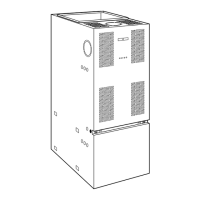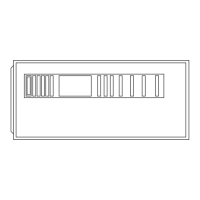The air handling capacity of this furnace is designed for cooling
airflow. Refer to Table 13 or 14 for expected airflows at various
external duct static pressures.
LOCATION
Step 1—General
ELECTRICAL SHOCK, FIRE OR UNIT DAMAGE
HAZARD
Failure to follow this warning could result in property damage
or personal injury or death.
This furnace is not water tight and is not designed for outdoor
installation. This furnace shall be installed in such a manner
as to protect electrical components from water. Outdoor
installation would lead to a hazardous electrical condition and
to premature furnace failure.
UNIT DAMAGE HAZARD
This oil furnace may be used for construction heat provided
that:
-The furnace operating conditions, including ignition, input
rate, temperature rise and venting, are verified per instruc-
tions in this manual
-The furnace is permanently installed with all electrical
wiring, piping, venting and ducting installed according to
these installation instructions. A return air duct is provided,
sealed to the furnace casing, and terminated outside the space
containing the furnace. This prevents a negative pressure
condition as created by the circulating air blower, causing a
flame rollout and/or drawing combustion products into the
structure.
-The furnace is controlled by a thermostat. It may not be ″hot
wired″ to provide heat continuously to the structure without
thermostatic control.
-Clean outside air is provided for combustion. This is to
minimize the corrosive effects of adhesives, sealers and other
construction materials. It also prevents the entrainment of
drywall dust into combustion air, which can cause fouling and
plugging of furnace components.
-The temperature of the return air to the furnace is no less
than 55°F, with no evening setback or shutdown. The use of
the furnace while the structure is under construction is
deemed to be intermittent operation per our installation
instructions.
-The air temperature rise is within the rated rise range on the
furnace rating plate, and the firing rate has been set to the
nameplate value.
-The filters used to clean the circulating air during the
construction process must be either changed or thoroughly
cleaned prior to occupancy.
-The furnace, ductwork and filters are cleaned as necessary to
remove drywall dust and construction debris from all HVAC
system components after construction is completed.
FIRE HAZARD
Failure to follow this caution may result in property damage.
For attic installation, it is important to keep insulation 12 in.
or more away from any furnace openings. Some types of
insulating materials may be combustibles.
This furnace is approved for reduced clearances to combustible
construction, therefore, it may be installed in a closet or similar
enclosure. Since this unit may be installed in an upflow, downflow,
or horizontal position, it may be located in a basement or on the
same level as area to be heated. In any case, unit should always be
installed level.
In a basement, or when installed on floor (as in a crawlspace), it is
recommended that unit be installed on a concrete pad that is 1 in.
to 2 in. thick.
When installed in downflow position, furnace must not be installed
on combustible flooring, unless approved subbase is used. Also,
since flue pipe is in a downflow position, Downflow
Conversion/Vent Guard Kit MUST be used.
When installed in a horizontal position, furnace may be suspended
by using an angle iron frame, as long as total weight of both
furnace and frame are allowed for in support calculations. (Other
methods of suspending are acceptable.) When installed in the
Horizontal Position, this furnace must not be installed on combus-
tible flooring, unless the approved Horizontal Subbase is used.
The required minimum clearances for furnace are specified in
Table 1.
The furnace should be located as close as possible to chimney or
vent in order to keep vent connections short and direct. The
furnace should also be located as near as possible to center of air
distribution system.
Step 2—Location Relative to Cooling Equipment
When installing furnace with cooling equipment for year-round
operation, the following recommendations must be followed for
series or parallel airflow:
1. In series airflow applications, coil is mounted after furnace in
an enclosure in supply-air stream. The furnace blower is used
for both heating and cooling airflow.
UNIT DAMAGE HAZARD
The coil MUST be installed on air discharge side of furnace.
Under no circumstances should airflow be such that cooled,
conditioned air can pass over furnace heat exchanger. This
will cause condensation in heat exchanger and possible
failure of heat exchanger which could lead to a fire hazard
and/or a hazardous condition which may lead to bodily harm.
Heat exchanger failure due to improper installation may not
be covered by warranty.
2. In parallel airflow applications, dampers must be provided to
direct air over furnace heat exchanger when heat is desired and
over cooling coil when cooling is desired.
IMPORTANT: The dampers should be adequate to prevent cooled
air from entering furnace. If manually operated, dampers must be
equipped with a means to prevent operation of either cooling unit
or furnace unless damper is in full cool or heat position.
3

